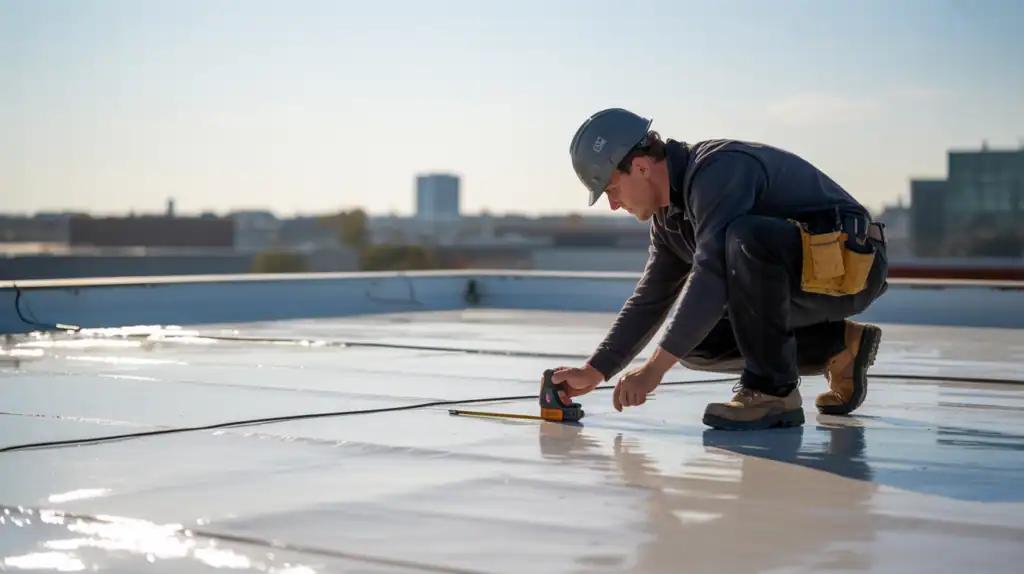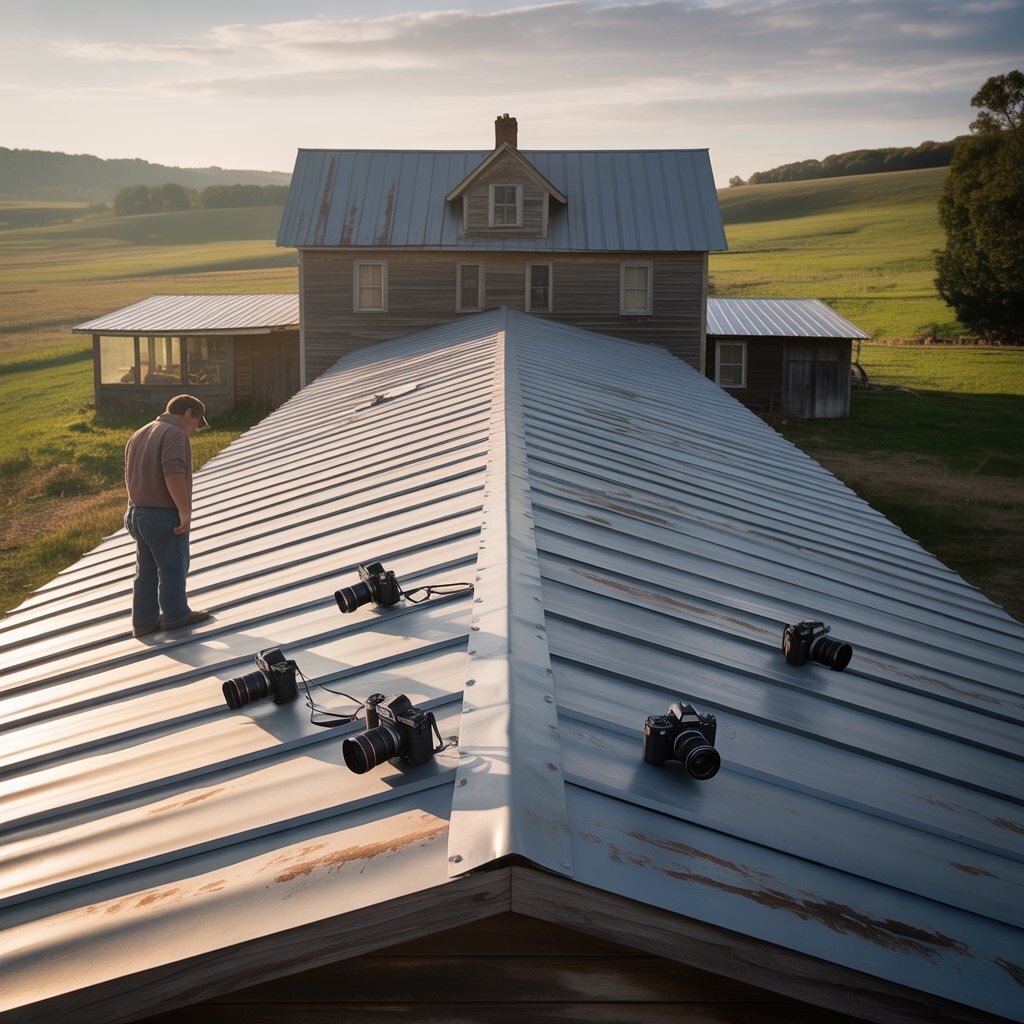Is your roof silently crying out for help? As a homeowner, you might be overlooking one of the most critical aspects of your property’s well-being. But how often should you tend to it, and what are the telltale signs of trouble?
Roof care isn’t just about aesthetics; it’s about protecting your investment and ensuring your home’s longevity. Regular preventive maintenance can save you from costly repairs down the line. Experts recommend inspecting your roof each spring and fall, as well as after any major storm.
Understanding the basics of roof maintenance is key for every Florida homeowner. From clearing debris to checking for signs of wear, these simple tasks can significantly extend your roof’s lifespan.
Let’s dive into essential Florida homeowner tips that will keep your roof in top shape, regardless of the season. We’ll explore everything from gutter care to tree management, ensuring you’re equipped with the knowledge to maintain a healthy, durable roof for years to come.
Understanding Your Roof’s Health: A Florida Homeowner’s Guide
Your roof protects your home from the outside world. It’s important to check it often to keep it in good shape. This guide will show you how to spot a healthy roof, common issues, and how weather impacts your roof.
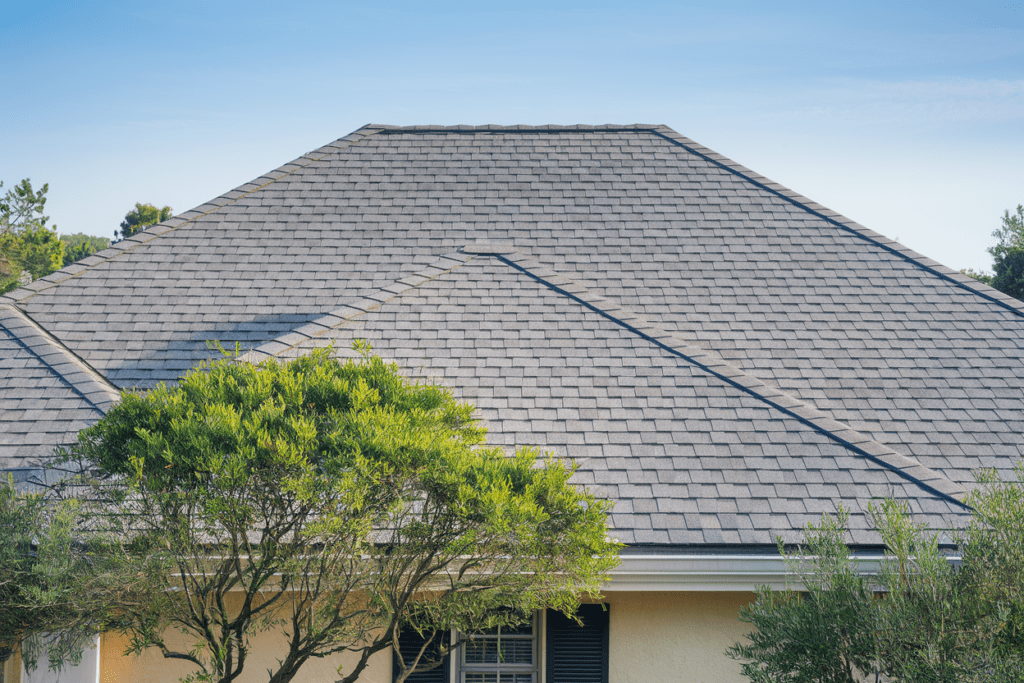
Signs of a Healthy Roof
A healthy roof looks good and shows no damage. Here’s what to look for during your check:
- Flat, undamaged shingles
- Clean gutters free of debris
- No visible moss or algae growth
- Intact flashing around chimneys and vents
Common Roofing Problems to Watch For
Spotting problems early can save you money. Keep an eye out for:
- Missing or damaged shingles
- Sagging roof deck
- Water stains on ceilings
- Granules in gutters
If you see any of these, it’s time to get a pro to inspect your roof.
Impact of Weather on Roof Condition
Weather greatly affects your roof’s life. Sun can crack and curl shingles, and storms can damage them right away. Also, changing seasons make roofing materials expand and contract, weakening them.
Knowing these weather effects helps you care for your roof better. Regular checks, after bad weather, are essential to keep your roof in top shape and protect your home.
Essential Seasonal Roof Inspections
Seasonal maintenance is key to protecting your roof. The National Roofing Contractors Association recommends checking your roof twice a year. This is best done in spring and fall. These inspections help find problems early and make your roof last longer.
Spring Inspection Checklist
When winter ends, it’s time to look for damage. Your spring roof inspection should include:
- Cleaning gutters to prevent water overflow
- Inspecting and repairing shingles
- Checking attic ventilation
Fall Preparation Guidelines
Before winter hits, get your roof ready with these steps:
- Trim nearby trees to prevent debris accumulation
- Inspect and maintain chimney and flashing
- Clear all roof debris
Post-Storm Assessment Tips
After severe weather, check for storm damage. Look for:
- Missing or damaged shingles
- Signs of water leaks in your attic
- Dents or cracks in roofing materials
Professional inspections can find hidden problems. By following this checklist and fixing issues quickly, you’ll protect your home and avoid expensive repairs.
Professional Roof Maintenance vs DIY Approaches
Homeowners face a choice: do it themselves or hire roofing experts. Many try DIY roof maintenance, but it’s risky. A survey showed over half found DIY projects harder than expected. Eight percent even damaged their homes.
Safety is a big worry with DIY roof work. Falls from roofs are a top cause of home injuries. Certified roofers follow strict safety rules, lowering accident risks. They also make sure repairs meet standards and codes.
Cost is another big factor. DIY might seem cheap, but mistakes can be expensive. Professionals offer warranties, covering unexpected costs. They work fast, finishing projects quicker than DIYers. This is key to prevent more damage from weather.
In Richmond, a mix of DIY and expert help works best. DIY tasks like gutter cleaning are okay. But for big issues or leaks, go with roofing experts. Annual inspections by pros catch problems early, making roofs last longer. This mix ensures your roof is well cared for.
Gutter Care and Management
Keeping your gutters clean is key to roof maintenance. Regular cleaning stops water damage and makes your roof last longer. Experts say to clean gutters twice a year, in spring and fall.
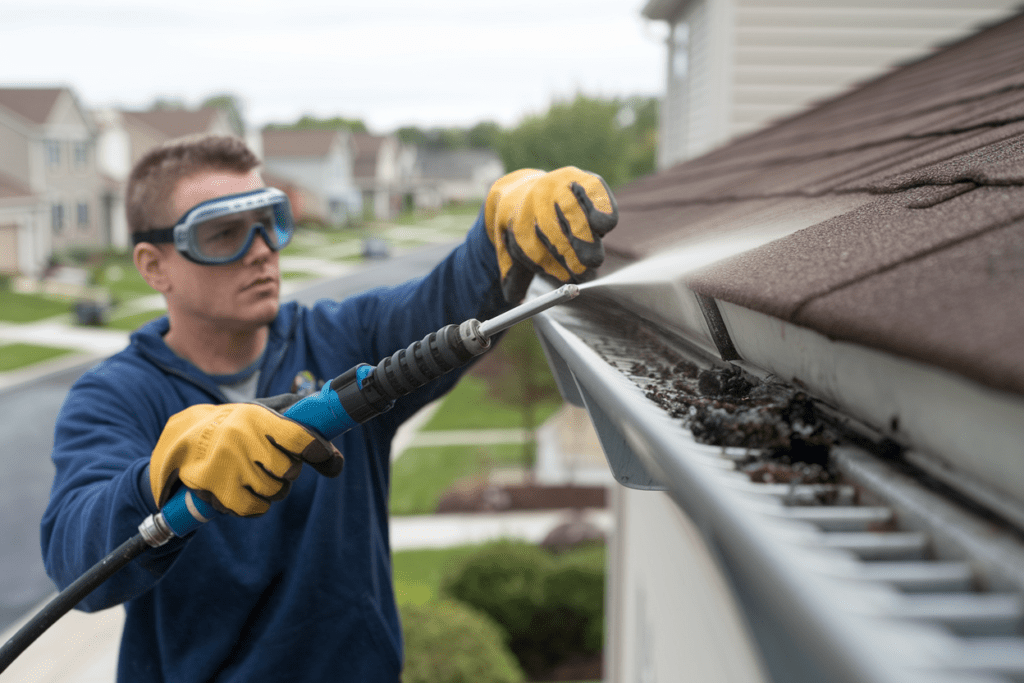
Proper Cleaning Techniques
Use a high-pressure hose to clean out debris from gutters. Wear gloves and goggles when removing debris by hand. Look for damage like splits, peeling paint, or sagging parts while cleaning.
Gutter Guard Options
Gutter guards help by stopping debris buildup. They let water flow while keeping leaves and twigs out. Installing them means less cleaning and fewer clogs for your gutters.
Downspout Maintenance
Don’t overlook downspouts in gutter care. Make sure they send water away from your home’s foundation. Use a garden hose to clear blockages in downspouts. This is key for good water drainage and avoiding water damage.
Regular gutter care keeps your roof and home safe from water problems. By following these steps, your gutters will work well all year. This protects your property from expensive repairs.
Tree Management and Roof Protection
Trees near your home can affect your roof’s health. They offer shade and protect from wind but can also cause harm. It’s important to manage trees well to protect your roof and make it last longer.
It’s vital to trim trees regularly. Make sure branches are at least 6 feet away from your roof. This prevents scratches and damage during storms. It also lowers the chance of heavy branches falling and damaging your roof.
When removing branches, do it with care. Talk to an arborist to find weak or sick branches that could harm your roof. They can also check the health of trees near your home and suggest removing them if needed.
Debris from trees can be a problem. Leaves, pine needles, and other organic matter can block gutters and lead to moss growth. Cleaning your roof and gutters often is key to avoiding water damage and keeping your roofing materials in good shape.
- Trim branches 6 feet away from roof
- Remove weak or diseased branches
- Clean roof and gutters regularly
- Consult an arborist for tree health assessments
Effective tree management lets you enjoy their benefits while keeping your roof safe. Regular upkeep and expert advice will help your trees and roof last longer.
Addressing Moss, Algae, and Mildew Growth
Roof cleaning is key for home upkeep, more so in humid areas like the southern U.S. Moss, algae, and mildew love damp, shaded spots. They cause ugly streaks and can harm your roof. We’ll look at ways to stop them, treat them, and keep your roof safe long-term.
Prevention Methods
To stop moss and algae, try these:
- Trim trees near your home to let in more sunlight
- Get rid of water on your roof
- Put up zinc or copper strips under shingles near the top
- Check your roof twice a year
Treatment Solutions
For moss and algae already there, moss removal and algae treatment include:
- Use commercial products like Spray and Forget (may take 3-6 months to work)
- Apply a mix of oxygen bleach cleaner and water
- Use a 50:50 water and bleach solution for cleaning
Don’t use high-pressure washers as they can harm your roof. For tough cases, get professional roof cleaning services.
Long-term Protection Strategies
To keep moss and algae away for good:
- Install zinc or copper flashing to stop growth
- Make sure your roof has good ventilation to reduce moisture
- Use preventative products with zinc or copper every year
- Fix any drainage or damp spots
By using these methods, you can keep your roof clean and healthy. Quick action is important to avoid damage from moss and algae.
Interior Signs of Roof Problems
Your home’s roof protects it from the outside world. Finding roof issues early can save you money. Here’s how to spot problems from inside your home.
Attic Inspection Guidelines

Checking your attic regularly is key. Look for:
- Water stains on rafters or insulation
- Damp or moldy smells
- Sagging deck boards
- Daylight peeking through roof boards
These signs mean you might have leaks or bad ventilation. If you see them, get a pro to check your roof.
Moisture Detection Methods
Water damage shows roof problems. Watch for:
- Peeling paint or wallpaper
- Water stains on ceilings or walls
- Mold or mildew growth
These signs mean water is getting in. Black roofs might hide damage, so check inside too.
Ventilation Assessment
Good ventilation stops moisture and extends your roof’s life. Look for:
- Excessive heat in the attic
- Ice dams in winter
- Rust on metal parts
Early roof checks save you money. If you see problems, call a roofing expert for help.
Essential Roof Maintenance Timeline
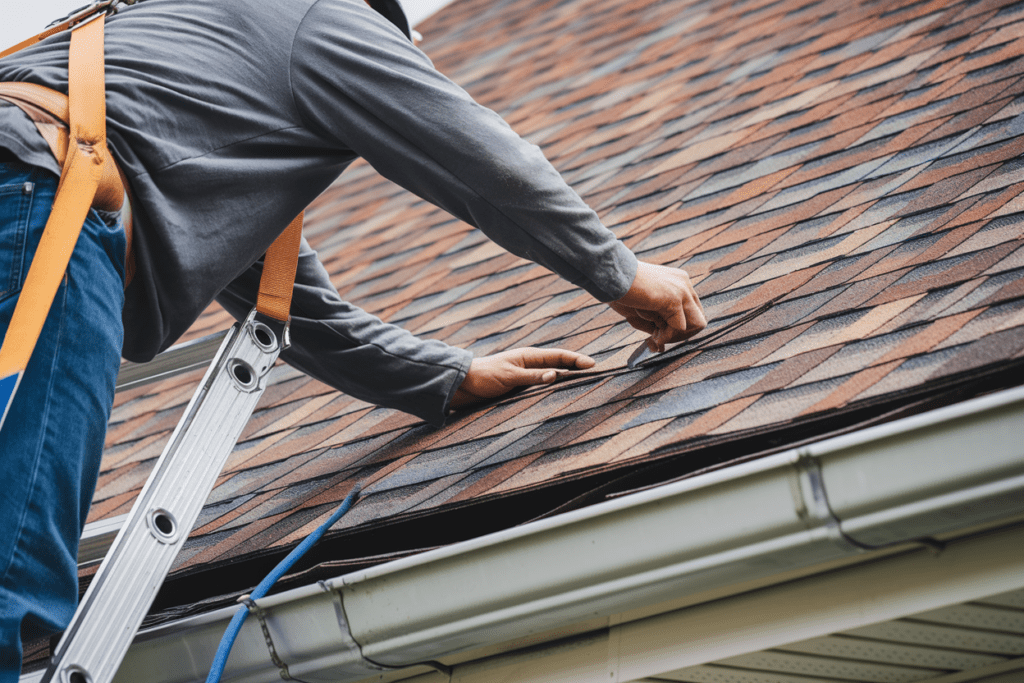
Having a good maintenance schedule is essential for your roof’s life. Regular upkeep prevents expensive fixes and keeps your roof in top shape. Let’s look at a timeline for seasonal care.
Spring and fall are key times for roof checks. Inspections during these seasons catch problems early. In spring, look for winter damage. Fall is for getting your roof ready for cold weather.
- Spring: Clean gutters, inspect shingles, check for leaks
- Fall: Remove debris, trim overhanging branches, seal any gaps
Annual professional inspections are a must. They take 45 minutes to 2 hours and find issues you might miss. Expert roofers offer valuable insights on your roof’s condition and needed repairs.
Gutter cleaning is needed at least twice a year. It stops water damage and ensures water flows right. Homes near trees might need more frequent cleaning.
With the right care, roofs can last 20-30 years. Being proactive can add up to 8 years to your roof’s life. Remember, your roof guards your biggest asset – your home. A solid maintenance plan is the secret to a long-lasting roof.
Conclusion
Roof care is very important. Regular maintenance can add 5-10 years to your roof’s life. Sadly, up to 50% of homeowners ignore this until problems show up.
Don’t wait until it’s too late. Taking care of your roof early can save you up to 50% on repairs later.
Professional roofing services are essential for your home’s safety. Experts can spot damage early, like missing shingles or flashing problems. They follow safety rules and offer plans to fix hidden damage before it gets worse.
A good roof does more than protect your home. It can also make your home more energy-efficient, saving you 10-15% on bills. It also makes your home look better and might even increase its value. By keeping your roof in good shape, you’re investing in your home’s future.
FAQs About Roof Maintenance
How often should I inspect my roof?
We suggest checking your roof twice a year, in spring and fall. Also, inspect it after severe weather. Regular checks help catch problems early and avoid big repairs.
What are some signs that my roof needs maintenance?
Look for missing, cracked, or curled shingles. Also, check for granules in gutters and wear around chimneys and vents. Water stains inside and moss or algae growth are other signs. If you see these, it’s time for a pro to check.
Can I perform roof maintenance myself, or should I hire a professional?
Homeowners can do simple tasks like cleaning gutters. But, for detailed care, it’s best to hire experts. They do thorough inspections and keep records. For complex or safety issues, always choose licensed and insured pros.
How important is gutter maintenance for roof health?
Gutter care is key for your roof. Clean them at least twice a year, more if you have trees nearby. Clean gutters help water flow away, protecting your roof and foundation.
How do trees affect my roof’s condition?
Trees can harm your roof. Branches can damage shingles in storms, and leaves clog gutters. Regular trimming and cleaning help protect your roof and extend its life.
How can I prevent moss and algae growth on my roof?
Ensure good ventilation and sunlight on your roof to prevent moss and algae. Use zinc or copper products annually to prevent growth. For existing issues, get professional cleaning. Regular care keeps your roof clean.
What should I look for during an attic inspection?
Look for water stains, wet insulation, and structural damage in the attic. Check for proper ventilation to prevent moisture. These signs can mean your roof needs attention.
How long should a well-maintained roof last?
A roof’s lifespan varies by material and climate. Asphalt shingles last 20-30 years, while metal roofs can last 50 years or more. Regular care and timely repairs extend your roof’s life.
What’s the best way to prepare my roof for winter?
Prepare your roof for winter by inspecting it in fall, cleaning gutters, and trimming branches. Ensure good attic insulation and ventilation. Fix any issues before winter to avoid damage.
How do I know if my roof needs replacement or just repairs?
Decide between repair or replacement based on your roof’s age, damage, and condition. If it’s old or damaged a lot, replacement might be better. A pro can help decide what’s best for your roof.


